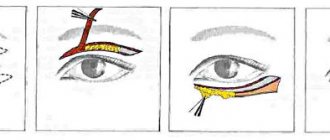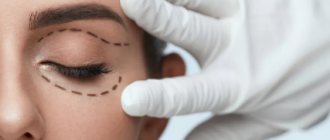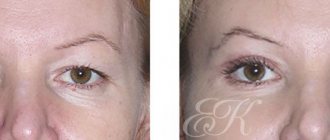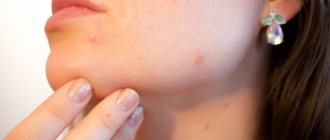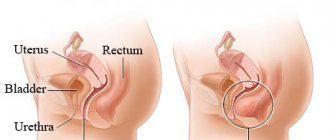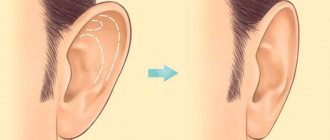Non-surgical blepharoplasty refers to cosmetic procedures and is an alternative to surgery. Allows you to eliminate fine wrinkles, tighten the skin of the eyelids and restore the elasticity of the skin. This procedure is very popular among women over 45 years old, because... Usually at this age problems arise in the upper and lower eyelids. This article describes in detail the procedure for non-surgical blepharoplasty (eyelid skin correction) and the results that can be achieved.
Main results
Most patients seek to improve the elasticity of the eyelids and their appearance through the procedure - blepharoplasty of the upper and lower eyelids . But not everyone is ready to undergo a full-fledged operation using general anesthesia for this purpose. As an alternative, people choose non-surgical blepharoplasty, which is less effective than surgery, but can solve minor and medium-sized problems of the lower and upper eyelids. If you are not planning big changes in this part of your face, then non-surgical blepharoplasty will be an excellent choice.
After the procedure and rehabilitation period, you will be able to get the following results:
- Correction of eyelid asymmetry
- Elimination of small and medium wrinkles in the eyelid area
- The problem of the impending eyelid is solved (removal of excess skin)
- Restoring the proper functioning of the skin layers in this area
- General improvement in skin metabolism (increased hydration)
- Comprehensive eye shape correction
- The condition of connective tissue and facial muscles improves significantly
- Excess fat deposits are removed
- Bags under the eyes – their size is significantly reduced (complete removal is possible with small sizes)
The main purpose of the procedure is to combat visible signs of aging on the facial skin.
The need for blepharoplasty occurs with age for each person individually. When the first age-related changes appear, you should immediately contact a specialist. Non-surgical blepharoplasty copes well with early problems of the lower and upper eyelids, but if you delay the process, you will have to undergo a full-fledged operation.
Blepharoplasty: stitches and scars after surgery
Regardless of the type of blepharoplasty chosen, the incisions are made in natural folds, due to which, after healing, the seams become almost invisible.
The method of classic upper eyelid surgery involves excision of overhanging skin in such a way that after healing the suture is hidden in the new fold of the eyelid. The incision is precisely measured down to millimeters, thanks to which the patient after the operation receives an open and youthful look without visible scars.- When performing lower blepharoplasty, the incision is made under the eyelash edge, also in a natural fold, in order to hide the plastic surgery performed after healing.
- The transconjunctival blepharoplasty method does not leave any visible scars after surgery. The essence of the operation is to make an incision on the inside of the eyelid.
Each specific type of eyelid surgery helps to get rid of sagging skin, remove folds, wrinkles or fat bags, but, nevertheless, this operation is considered the least traumatic and fastest to heal.
If you choose a competent specialist and perform a high-quality operation, the stitches will be invisible even upon close examination.
Visible scars after healing are a sign of poor quality work by a plastic surgeon or non-compliance with recommendations by the patient, except in isolated cases.
Circular blepharoplasty photo
In the photo: a patient after circular blepharoplasty
Memo to the patient after blepharoplasty
What you need to know and follow after blepharoplasty to achieve an excellent result:
- It is necessary to sleep on your back or side with your head elevated
- Minor postoperative pain may occur, which can be easily relieved with regular painkillers. If you experience significant pain, you should notify your surgeon immediately.
- Cold compresses should be applied for 15 to 30 minutes at least 6 times a day
- Important! Do not take aspirin or medications containing aspirin. For the upper eyelid, apply a special ointment 3 times a day. The doctor will give recommendations.
- For the lower eyelids, use eye drops (usually 1 drop 4 times a day)
- Do not use mascara, eyeliner, or eye shadow until cleared by your doctor (usually 10 to 14 days). Minimal makeup can be applied to areas of bruising on the lower eyelid, but is not acceptable for the upper eyelid, much less incision areas.
- Strenuous exercise and sports should be avoided for at least 3 weeks
- Avoid high temperatures (saunas or steam baths), as well as exposure to ultraviolet radiation (solarium or tanning) for a month
- When performing transconjunctival lower eyelid surgery, it is necessary to use sunscreen for a month after surgery.
Types of non-surgical blepharoplasty
Thanks to advances in technology, several types of non-surgical blepharoplasty are available today. Each type has its own advantages and disadvantages, as well as differences in the rehabilitation period. Basically, they can be divided into 2 categories: hardware and injection.
Laser blepharoplasty
This procedure can rightfully be called the most effective in the non-surgical category. Now the laser allows you to effectively influence the skin of the eyelids and carry out lifting at a high level. Most laser systems have flexible settings for the length and other parameters of the laser beam, which in turn allows you to select an individual program for each patient. If necessary, it is possible to minimally narrow the size of the laser beam and achieve a targeted effect on the required areas of the skin.
The safety of laser blepharoplasty is at a high level - this was achieved due to 2 key factors:
- Correct choice of laser beam intensity
- Possibility of individual adjustment based on the characteristics of the lower and upper eyelids of the individual patient
It is possible to restore the normal appearance of the skin of the eyelids without plastic surgery, because... The laser effectively removes excess skin (solves the problem of drooping eyelids). The problem of fat deposits is also solved effectively and without significant consequences.
Advantages of laser blepharoplasty relative to plastic surgery:
- Plastic surgery leaves noticeable seams (they disappear over time, but this is not a quick process)
- Laser blepharoplasty leaves no scars
- Unlike classical surgery, the result is visible immediately
- No severe bleeding or damage to small vessels of the eyelids
- Laser cauterization of tissue provides a disinfecting effect
- Great for correcting both the lower and upper eyelids
- For minor interventions, it is better to choose a laser procedure
Recently, Asian patients have been actively using blepharoplasty to change the shape of their eyes. The laser copes well with this procedure and can serve as a complete alternative to surgery.
Despite all the advantages of the laser, it is not able to remove large defects, but it copes with medium and small ones extremely effectively. Non-surgical blepharoplasty provides a lifting effect, resurfacing of the eyelid skin and restoration of the upper layer.
All this has a positive effect on the skin and in the shortest possible time you will get a rejuvenating and refreshing effect.
What to prefer: laser or scalpel?
The first visit to a plastic surgeon is always fear and doubt. Women frightened by horror stories often put off visiting a specialist until the last minute.
Among the most common fears is the fear of complications, scars and hematomas, and of course the operation itself. If you are one of those, then you should prefer laser surgery, since the laser, in addition to being a powerful and at the same time neat tool, has a number of advantages for both the doctor and the patient. How is a laser superior to a scalpel?
Minimum injuries
It allows you to achieve a significant reduction in the wound caused during surgery, while significantly reducing the required recovery period. The laser causes less trauma to surrounding tissue, and the incision made during laser surgery heals much faster.
No swelling or hematomas
The likelihood of hematomas and edema after laser surgery is several times less, since the laser beam, due to its high temperature, promotes cauterization of small vessels.
No scars
By choosing a laser, you do not have to worry about scars, since the wound heals without a scar, which is impossible to achieve even using the best scalpel.
No infections
The laser leaves no opportunity for infection to enter the blood, since the walls of the wound are reliably “sealed”.
No need to go to hospital
Laser surgery does not require hospital monitoring; within a few hours you can be at home and see a specialist only to monitor the recovery process.
Long lasting effect
The effect of laser surgery lasts forever: you will always look younger than your age!
Note! The patient can be operated on with carbon dioxide and erbium laser beams. A carbon dioxide laser beam is able to penetrate into the deep layers of the skin, cauterizing blood vessels, which allows you not to worry about the possibility of bleeding. However, this same property of the laser beam can cause complications, such as skin burns and pain in the patient.
The erbium beam allows the operation to be performed without burns, since it does not penetrate deep into the tissue. Laser eyelid blepharoplasty itself can be performed either surgically or without surgical intervention.
CHIRURGIE DES PAUPIÈRES\n\nDOCTEUR JEAN-LOUIS DURAND :\n8ème étage, du 74 av du Général de Gaulle, 72 000 Le Mans\nTÉLÉPHONE :\n02 43 76 96 00\n\nhttps://dr-jl-durand. com/chirurgie-esthetique/la-chirurgie-des-paupieres
Injection procedures
The essence of the procedure is that drugs are injected into the eyelid area to increase the elasticity of the skin, eliminate age-related changes (minor), and also provide a better appearance of the skin around the eyelids. Hyaluronic acid is most often used as a drug due to its high compatibility with skin components.
The most common 2 types of procedures:
- Blepharoplasty is aimed at eliminating fatty formations in the lower and upper eyelids. This is a set of procedures that includes biorepitalization and hyaluronic therapy.
- Injections to smooth out the contour of the eyelids and achieve a lifting effect both in the eyelid area and neighboring areas. The procedure significantly increases the elasticity of the eyelids and provides nourishment to the skin.
Results of injection therapy:
- The skin of the eyelids becomes elastic and renewed
- Eliminates swelling in the eyes and eyelids
- Eliminate fine wrinkles with lifting
- The asymmetry of the eyelids is partially smoothed
- The patient's lower and upper edges of the eye are smoothed
The result will depend on the chosen procedure. An experienced cosmetologist is able to select an effective solution only after an initial examination. Injection therapy will not be able to give the same effect as laser blepharoplasty or plastic surgery, but in terms of the result/safety ratio, it is a compromise solution for those who want to get a good result with minimal intervention.
Hardware blepharoplasty
People often confuse hardware blepharoplasty with laser. Hardware techniques are based on tightening the facial skin using various procedures. Increased collagen and elastin, as well as rapid improvement of skin tissue are the main advantages of this technique.
The main procedures included in the group of hardware blepharoplasty are described below:
- Non-surgical blepharoplasty using plasma current. The essence of the procedure is the effect of electric current on the eyelid area, which causes heating of the skin, improves metabolism and the appearance of the skin of the eyelids. The main feature of this procedure is the targeted impact of low-power current - this allows you to not injure the skin, and the patient does not feel pain.
- Ultrasonic smas lifting is the effect of ultrasonic waves on the skin of the eyelids. The peculiarity of the procedure is the penetration of waves into depth, which allows you to achieve a good lifting effect in all areas. Restoring the elasticity of collagen fibers is another advantage of this technique.
- Thermage is a procedure using high-frequency radio waves. Requires the use of local anesthesia as it is not painless. The process is similar to the use of plasma current, only in this case the skin is heated more actively and a larger area is affected. The effectiveness of this procedure is at a high level, but rehabilitation leaves much to be desired.
Hardware blepharoplasty is often called electroblepharoplasty .
Despite the fact that laser technologies have stepped forward and now have several undeniable advantages over electrical devices, many people continue to use these procedures. Such procedures are best used in comprehensive facial rejuvenation.
Endoscopic blepharoplasty of the lower and upper eyelids
Endoscopic blepharoplasty is a modernized method of eyelid lift (analogous to the classic version with some modifications). This procedure is primarily suitable for patients under 45 years of age (as it is not intended to address large defects or significant signs of aging).
The main advantages of the technique:
- Lowest level of injury
- Minimum recovery period
- No contraindications (with a few exceptions)
How is endoscopic blepharoplasty performed:
- A special device is used - an endoscope equipped with a small camera that transmits video to the doctor’s monitor.
- A microscopic incision is made in the correction area through which special instruments are inserted.
- The doctor carefully corrects imperfections and provides a lifting effect in the eyelid area
Due to the small incision used, there are no scars left on the face after surgery.
Thread blepharoplasty
Thread blepharoplasty is carried out by introducing special gold threads into the skin, which in turn provide a lifting effect for the treated area. The main feature of the procedure is the effect of golden threads.
Results of the thread method:
- Stimulation of metabolism in the eyelid area
- Significant influx of oxygen into skin tissue
- Skin nutrition and hydration are significantly improved
- Microcirculation is restored
All this is achieved due to the effect of gold on the biological tissues of the facial skin. This procedure cannot be called therapeutic, because... it is not intended to solve significant problems in the lower and upper eyelids. But it is excellent for preventing aging, as well as for eliminating minor age-related changes. Can be effectively used in combination, for example with laser rejuvenation .
Meaning 3. Laser blepharoplasty is laser peeling around the eyes
For laser peeling at Platinental we use the Asclepion Dermablate erbium fractional laser (Germany).
In this case, the penetration of a beam of thin laser beams is carried out to a depth of 50 to 150-200 microns. The impact of the laser is less deep than with resurfacing, so rehabilitation after the procedure is much faster.
Due to the effect of uniform light refraction, the skin after laser peeling looks radiant and healthy. The laser allows you to remove old layers of the epidermis in the area of the delicate skin of the eyelids with micron precision. Laser peeling under the eyes gives the best results: improves skin color, reduces circles under the eyes, eliminates swelling and puffiness, tightens the skin and tightens it.
This method of fractional exposure does not require long-term rehabilitation - skin redness and uniform peeling disappear within just 72 hours and allows you to return to your normal lifestyle. Peeling is ideal for people with early age-related skin changes.
Laser peeling of the eye area is indicated in the following cases:
- wrinkles and folds of small depth, “crow’s feet”,
- hyperpigmentation, sallow complexion,
- loss of natural elasticity of the skin,
- spider veins,
- uneven skin,
- skin dehydration.
It should be remembered that the procedure is not done in active sun, so the best time for peeling is early spring and late autumn.
You don't have to immediately start with a deep laser resurfacing procedure under the eyes. You can perform 3-4 peeling procedures over the course of a year with an interval of 3 months and in most cases obtain a comparable effect.
Main indications for non-surgical blepharoplasty
It's no secret that patients undergo blepharoplasty with one main goal - rejuvenating the skin around the eyelids and fighting the signs of aging . The main problems and indications for the procedure are described below:
- Asymmetry of the eyelids, namely their positions relative to each other
- Drooping eyelids (ptosis)
- Fatty formations in the upper and lower eyelids
- Drooping eyelids and various excess skin
- Dry skin around the eyes
- Small and medium wrinkles
- Pronounced bags under the eyes are the most common reason for treatment
In the case of bags under the eyes, it is important to understand that not all stages are amenable to non-surgical techniques. Large bags can only be removed surgically.
You don't have to have one or more of the problems listed above. The desire to improve the appearance and elasticity of the skin in the upper or lower eyelid area is enough. Preventive procedures help prevent complications and keep facial skin in good condition.
Medical indications
It happens that a patient comes for laser correction not of his own free will, but on the recommendation of other specialists. This happens when he needs to eliminate the overhang of the upper eyelid or correct the drooping lower eyelid. You will also be advised to meet with a plastic surgeon if you suffer from excess skin on your eyelids or “fatty hernias”. Deformation of the eyelids and facial asymmetry can also be an indication for surgery. It is important to understand that indications can be not only aesthetic, such as a tired or even angry appearance, but also indications can be medical, when an impending eye infection can threaten normal functioning!
Contraindications to the procedure
The non-surgical blepharoplasty procedure is completely safe , however, there are several contraindications that should not be ignored:
- The presence of malignant neoplasms and tumors
- Diabetes mellitus in the acute phase
- Bleeding disorder
- Acute infectious diseases, including infectious skin diseases and chronic inflammation
- Acute diseases of the respiratory system and heart
It is worth refraining from the procedure during periods of lactation and pregnancy, because... Stress can harm a child's health. For more detailed information about contraindications, ask a specialist in hardware cosmetology.
Contraindications and possible complications
Like any procedure, this one also has contraindications. Thus, a specialist will refuse to help a patient with increased sensitivity to the laser or with existing inflammation at the site of the planned operation. Laser eyelid blepharoplasty is not recommended for people:
- with problems in the functioning of the endocrine system;
- with increased intraocular pressure;
- having chronic diseases (during exacerbation);
- with HIV infections;
- having tumors of various degrees;
- with blood clotting disorders.
After surgery, your eyes may feel dry or have constant watery eyes. This complication is the result of improper functioning of the lacrimal glands; it goes away within a maximum of 2 weeks. During the operation, the integrity of the blood vessels is compromised, which often leads to swelling of the area around the eyes and hematomas. When contacting a low-qualified specialist, the patient may notice that after the operation he has asymmetry of the eyelids or his eyes will no longer close completely. When choosing a carbon dioxide laser, patients rarely experience burns. There may also be burns from surgical blades during surgery; this is a rare but possible complication that a specialist will definitely warn you about.
Preparatory stage
Non-surgical blepharoplasty is performed on an outpatient basis ; it does not require going to the clinic for a long time. The procedure itself is preceded by an examination by a dermatologist, during which the doctor will assess the condition of the eyelids and draw up an individual treatment and correction plan. What you need to do before the non-surgical blepharoplasty procedure:
- A blood test, coagulogram and ECG are performed to assess the patient’s general condition
- Based on the data obtained from the tests, the doctor decides whether to admit the patient to the procedure.
- Computer modeling is necessary to generate a preliminary result, according to the client’s preferences and specialist recommendations.
A preliminary assessment of the condition of the eyelids takes into account: the tone of the cartilage tissue, the presence of excess skin and the depth of wrinkles.
The main stages of non-surgical blepharoplasty
Non-surgical blepharoplasty of the lower and upper eyelids in most cases consists of the following stages:
- Disinfection of the skin of the eyelids
- Special protective lenses are placed on the patient's eyes.
- The blepharoplasty procedure itself, depending on the type chosen: injection or hardware
- Repeated disinfection of the treated skin surface
- A cooling compress is applied to quickly relieve swelling
- The patient begins the rehabilitation period at home
To achieve a more accurate lifting result, eyelid marking is used before the non-surgical blepharoplasty procedure itself. Thanks to this additional stage, it is possible not only to predict the final result, but also to agree on individual details with the patient.
How to behave after non-surgical laser eyelid lift?
For several days after the procedure for lifting the upper eyelid without surgery, you should follow the recommendations of the plastic surgeon, which he gives during the consultation after non-surgical blepharoplasty. A soothing cream is applied to the treated area. There is no need to be in the sun, and if you must go outside, it is recommended to use sunscreen.
Features of the rehabilitation period
Compliance with all recommendations during the rehabilitation period by the patient is the key to the success of the procedure. Proper care will not only help reduce discomfort (for example, after grinding), but will also ensure faster healing and renewal of the skin.
Some recommendations that must be followed during the rehabilitation period:
- Avoid wearing makeup or cosmetics in the eye area - it can cause irritation, which in turn will slow down the recovery process.
- Sunglasses are a must because... they provide reliable protection from sunlight (exposure to which is contraindicated during the rehabilitation period). Glasses are the best choice because... After blepharoplasty, it is highly not recommended to use SPF creams for sun protection.
- You can and even need to use restorative agents to quickly get rid of bruises and swelling. In this matter, you should trust your doctor; any amateur activity can not only worsen the results of the procedure, but also cause skin irritation.
- No solariums, baths or saunas - high temperature and humidity will ruin the result of the operation, and swelling will take much longer to go away. The duration of such a ban is again determined by your attending physician.
Your doctor may schedule follow-up appointments to monitor your situation and improve your outcome during the rehabilitation period—never miss these appointments.
How long does the result last after the procedure?
This primarily depends on the type of non-surgical blepharoplasty chosen. For example, laser treatment can provide a more lasting effect than injections.
- On average, after injection therapy, the result lasts for 2-4 years.
- As for hardware cosmetology , it depends on the chosen technique. On average from 5 to 8 years.
We recommend laser blepharoplasty because... At the moment, it outperforms all other methods in terms of the ratio of benefits. The maximum lasting effect, the predicted result, solves most problems with the lower and upper eyelids - the main advantages of laser blepharoplasty.
In conclusion, we suggest watching a video about laser blepharoplasty in our clinic :
Prices for blepharoplasty in Moscow
The cost of blepharoplasty depends on the complexity, the chosen method, the qualifications of the plastic surgeon, the level of service in the clinic, anesthesia and consumables. As a rule, everything is included in the price, except for tests, which you can pre-take either in the clinic itself or in any place convenient for you. Blepharoplasty is one of the most affordable anti-aging facial surgeries in Moscow.
In our clinic, the cost of blepharoplasty starts from 60,000 rubles. In your specific case, it will be possible to announce the price of blepharoplasty only after examination during a face-to-face consultation.
The consultation is free , sign up by calling +7 and 7 (495) 225-95-41 or using the feedback form in the site header.
